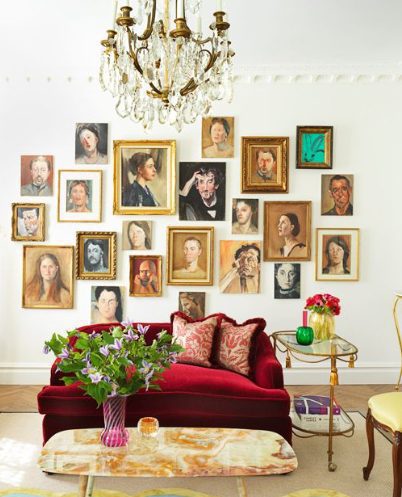Finding and bringing home the perfect painting, sculpture or piece of art is often the most exciting part of collecting. The challenge for any collector, however, is to make each piece look as good as it did when it was new, even decades later. Caring for your artwork starts before it's even hung on the wall.
Follow the advice of BG Crafts Gallery here:
Frame it right
When you invest in art, invest in a frame! Although the look and style of the frame is a matter of aesthetic preference, it is imperative that any frame should always be well made and with properly joined corners. Never crop a picture to fit the frame. If you're not sure how to go about it, visit a professional or framing studio.
Framing materials. Usually, frames are made of wood or composite materials and should be easy to clean from dust and dirt. If your frame is unpolished, raw wood, be prepared to spend a little more time dusting. Untreated wood has the property of holding dust in the irregularities and pores of the material and needs additional time to clean. Do not use wood cleaner or wax unless you remove the artwork from its frame first. Even if you are very careful, cleaning materials and waxes can seep under the frame and stain your painting.
Whether your painting needs safety glass depends entirely on the type of framed artwork. The texture characteristic of oil and acrylic paintings, for example, can be crushed behind glass, and such paintings may not be suitable for a glass frame. On the other hand, watercolor is on paper and framing it and protecting it with glass is always a good idea. Never spray glass cleaner directly onto the safety glass. It is possible for the detergent to leak behind the frame and wet your artwork.
Positioning, positioning, positioning
While you probably love your sunny living room, it's not a good place for photos or artwork made on paper. The two main culprits for faded or distorted artwork are extreme temperatures and direct sunlight. Other places you should keep your artwork away from are wet rooms, the bathroom, and placing it directly over heaters and radiators.
Do you have to travel? Ask a friend to stop by to ventilate and adjust the temperature if necessary. For longer trips, arrange for professional storage of your more valuable pieces.
Sunlight
Sunlight is the main enemy not only of your wine and woodwork, but also of artwork. UV rays cause colors to fade and lose their luster and brightness. This applies equally to dyes and photographs. Sunlight will damage your artwork unless you have special UV protection film applied to windows that are not UV resistant glass.
Temperature
Room temperature plays a huge role in preserving artwork. The reasons why libraries control their temperature are the same reasons why art gallery owners are meticulous about getting the temperature right. Although it is difficult to achieve an ideal temperature at home, you can always choose places that are more favorable for your exhibits and where you can avoid damage caused by improper temperature, such as fading, peeling or dampness. Generally speaking, artwork likes cooler temperatures. Be careful, however, because at too low a temperature, the paint starts to peel and crack. The ideal temperature to store your art is slightly lower than normal room temperature.
Moisture
When planning the decoration of a particular room and the storage of artwork, humidity is a huge factor to consider. Water has the potential to damage artwork just as much as sunlight, but in slightly different ways.
Usually, the paint runs, cracks and peels, and usually the damage is irreversible. Watercolor or acrylic paint runs when exposed to water, and even oil paintings are damaged if they absorb moisture and water.
Improper and uncontrolled humidity is responsible for the appearance of mold and mildew in canvases, the paper base of paintings and photographs, as well as in wood. Its removal is practically impossible without causing additional damage to the work.
High humidity areas such as bathrooms and laundry rooms are difficult to decorate with artwork because they are constantly exposed to steam and moisture. However, you can decorate your bathroom and laundry room, but it is good to prepare in advance. Canvases should be well primed, and oil-based paints naturally repel water, so oil paintings may prove more suitable for such damp spaces.
Consider Plexiglas
Before you rush out to buy anti-reflective museum glass to protect your artwork, consider UV Plexiglas. Many experts prefer it because it is much lighter and less prone to breaking, and your works are protected from the harmful effects of strong sunlight. No matter what you choose (glass or Plexiglas), be extra careful when cleaning the surface. Use a product that will not streak or damage the finish. Avoid spraying cleaner directly onto the glass – it can drip and seep into the work. Once a week, carefully clean the frames from dust.
Treat with due care and attention
The move an object of art in a new place, whether it's just the next room or a whole new home requires special attention and care. Always pack pictures on a horizontal surface and try not to bump them into each other. Do not wear any jewelry - no wedding rings, rings or bracelets.
Choosing the best place for your art
Planning where to place a piece of art is a very important part of ensuring that it will stand the test of time without being damaged. Here are some important things to keep in mind.
Storage
Do's and Don'ts with Artwork:
What to do:
• Store your artwork in a cool (but not cold) place. The ideal temperature range is 70-75 degrees Fahrenheit (21-23 degrees Celsius).
• Double-check that all your framing materials are acid-free.
• Store your paintings and wall decorations away from direct sunlight. If necessary, wrap them with vinyl or nylon.
• The ideal humidity range is 40-50%.
• Take a photo of your artwork before sending it into storage and note when it went into storage and any existing damage.
• If you can, leave your artwork in the safe hands of an art warehouse.
What not to do:
• Store your artwork in the attic if you live in countries with a warm climate. Although attics may seem like dry and safe places to store art, if you live in an area that gets hot (even for just a few months in the summer), it can be enough to cause damage such as warping, cracking and peeling.
• Store your artwork in a basement. Like a loft, this might seem like the perfect place because it's cool, out of the way and out of the sun. The catch is that basements are often damp.
• To leave works of art in storage without protective covering and packaging. Packaging doesn't have to be complicated. Sometimes placing a picture between two pieces of cardboard is quite enough. Whatever packaging you choose, just make sure that the work will not be exposed to dust and direct sunlight.
Professional care
If your painting gets damaged, you can always take it to a professional to fix it. There are restoration professionals whose services are more expensive and are usually only used for particularly valuable items that need extensive repair.
Another option is to return your work to the artist who made it and ask for their help. If this is not possible, you can ask another creator if they would be willing to make this adjustment for you. As a rule, this is the most budget solution and you can easily find an artist in your area or seek help from us at BG Crafts Gallery.
Do it yourself
If, for example, you have a painting that is scratched and the scratch is only a few centimeters long, and it is located on a red area of your artwork, you can try to remove the scratch yourself. Go to an art supply store and ask them to help you choose a color and paint. Grab a small tube of this paint and a brush and when you get home, awaken your inner Picasso and go wild with the brush!
If your wood frame is scratched, you can remove the scratch by sanding it or using a scratch filler. Before repairing, photograph the scratch and go to a hardware store. The staff there will help you choose the right materials and tools.
Now you know what to do and how best to care for your artwork, so you have no excuses for sun-faded paintings or photos.
And if you want something new for your collection or to replace something old and damaged, visit our gallery: https://bgcraftsgallery.com/en/tvorbi/

